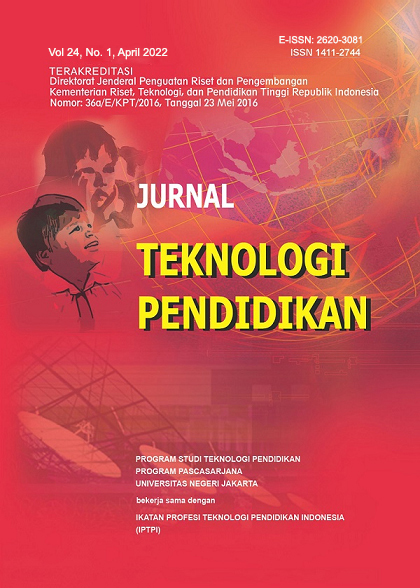Effect of Blended Learning in high school Japanese Language Learning outcomes
DOI:
https://doi.org/10.21009/jtp.v24i1.26245Keywords:
blended learning, contextual learning, learning outcomesAbstract
This study aimed to determine the effect of blended learning-based contextual learning and independent learning on Japanese language learning outcomes of students at SMA Negeri 1 Setu. The ability to read and write kana (hiragana and katakana) is very important for basic level Japanese learners to support learning at the next level. Blended learning-based learning is the best choice to increase effectiveness, efficiency, during the current pandemic. With blended learning, interaction and communication between students and between teachers and students can continue. This paper will discuss the meaning of blended learning, the advantages and disadvantages of blended learning and the design of blended learning implementation. This study aims to determine the ability of students in mastering hiragana letters and simple grammar using a blended learning model. The author uses online learning (e-learning) with Zoom and Google Classroom applications. This study used an experimental method with level 2 x 2 treatment. The sample of this study amounted to 35 students of class X Language SMAN 1 Setu Bekasi. The research instruments used were tests, questionnaires and observation sheets. The results of this study conclude that Gakkouno seikatsu learning outcomes are higher with contextual learning strategies with blended learning than conventional learning strategy. It is recommended that the blended learning strategy can be used as an alternative learning process in Japanese language learning.
References
Anwar, Miftahulkhairah, R. A. P. (2020). RELATIONSHIP OF WRITING LEARNING PROCESSES WITH LANGUAGE ERRORS OF STUDENT EXPOSITION. 19.
Danver, S. L. (2016). International Society for Technology in Education. In The SAGE Encyclopedia of Online Education. https://doi.org/10.4135/9781483318332.n193
Darmawan, A. (2019). Pengaruh Pendekatan Blended Learning Menggunakan Portal Rumah Belajar Terhadap Hasil Belajar Ipa the Effect of Blended Learning Approach By Utilizing “Rumah Belajar” Portal on the Learning Outcomes of Integrated Science. Jurnal Teknodik, 17(3), 065. https://doi.org/10.32550/teknodik.v17i3.562
Din, N., Haron, S., & Rashid, R. M. (2016). Can Self-directed Learning Environment Improve Quality of Life? Procedia - Social and Behavioral Sciences, 222, 219–227. https://doi.org/10.1016/j.sbspro.2016.05.150
Heinze, A., & Procter, C. (2004). Reflections on the use of blended learning. Education in a Changing Environment, 1–12. http://www.ece.salford.ac.uk/proceedings/papers/ah_04.rtf
husamah, Y. pantiwati, A. (2010). Belajar Dan Pembelajaran. August, 34.
Indrilla, N. (2018). The Effectiveness of Scientific Approach and Contextual Teaching and Learning Approach in Teaching Writing. Lingua Cultura, 12(4), 405. https://doi.org/10.21512/lc.v12i4.4452
Kintu, M. J., Zhu, C., & Kagambe, E. (2017). Blended learning effectiveness: the relationship between student characteristics, design features and outcomes. International Journal of Educational Technology in Higher Education, 14(1). https://doi.org/10.1186/s41239-017-0043-4
Kumar, A., & Gottlich, M. (2013). Flipped Classroom : A coderdojo (Issue Brame).
Li, Y. (2018). Current problems with the prerequisites for flipped classroom teaching---a case study in a university in Northwest China. Smart Learning Environments, 5(1), 1–24. https://doi.org/10.1186/s40561-018-0051-4
Munir. (2017). Pembelajaran Digital. In Alfabeta. https://www.google.com/url?sa=t&source=web&rct=j&url=http://file.upi.edu/Direktori/FPMIPA/PRODI._ILMU_KOMPUTER/196603252001121-MUNIR/BUKU/Pembelajaran%2520Digital.pdf&ved=2ahUKEwj-oITXwpbpAhWf7HMBHYxmDaIQFjAAegQIARAB&usg=AOvVaw3FGMSFjUjBN9Rjdvb5NBzI&cshid
Nurhadi, N. (2020). Blended Learning dan Aplikasinya di Era New Normal Pandemi Covid-19. Agriekstensia, 19(2), 121–128.
Philiyanti, F., & Rismorlita, C. E. (2020). Analisis Kebutuhan Bahan Ajar Membaca Bahasa Jepang Tingkat Pemula Berbasis Keterampilan Abad 21. 1.
Ramadania, F., & Aswadi, D. (2020). Blended Learning dalam Merdeka Belajar Teks Eksposisi. STILISTIKA: Jurnal Bahasa, Sastra, Dan Pengajarannya, 5(1), 10–21. https://doi.org/10.33654/sti.v5i1.1014
Sarah, S. (2019). Pengaruh Model Pembelajaran dan Kecerdasan Intelektual terhadap Hasil Belajar Bahasa Indonesia Baku. Diskursus: Jurnal Pendidikan Bahasa Indonesia, 1(01), 82. https://doi.org/10.30998/diskursus.v1i01.3515
Selvianiresa, D., & Prabawanto, S. (2017). Contextual Teaching and Learning Approach of Mathematics in Primary Schools. Journal of Physics: Conference Series, 895(1). https://doi.org/10.1088/1742-6596/895/1/012171
Surjono, H. D., Muhtadi, A., & Trilisiana, N. (2019). The effects of online activities on student learning outcomes in blended learning environment. ACM International Conference Proceeding Series, July, 107–110. https://doi.org/10.1145/3345120.3345167
Syakdiyah, H., Wibawa, B., & Muchtar, H. (2018). The effectiveness of flipped classroom in high school Chemistry Education. IOP Conference Series: Materials Science and Engineering, 434(1). https://doi.org/10.1088/1757-899X/434/1/012098
Yuniarsih, Y., Hapsari, E. K., & Zakaria, M. (2020). Blended Learning Approach Using Flipped Classroom Model on Kaiwa Iii. Jurnal Kata, 1, 28. https://doi.org/10.22216/kata.v1i0.5064
Downloads
Published
How to Cite
Issue
Section
License
Jurnal Teknologi Pendidikan is an Open Access Journal. The authors who publish the manuscript in Jurnal Teknologi Pendidikan agree to the following terms.
Attribution-ShareAlike 4.0 International (CC BY-SA 4.0)
-
Attribution — You must give appropriate credit, provide a link to the license, and indicate if changes were made. You may do so in any reasonable manner, but not in any way that suggests the licensor endorses you or your use.
-
ShareAlike — If you remix, transform, or build upon the material, you must distribute your contributions under the same license as the original.
- No additional restrictions — You may not apply legal terms or technological measures that legally restrict others from doing anything the license permits.
Notices:
- You do not have to comply with the license for elements of the material in the public domain or where your use is permitted by an applicable exception or limitation.
- No warranties are given. The license may not give you all of the permissions necessary for your intended use. For example, other rights such as publicity, privacy, or moral rights may limit how you use the material.








